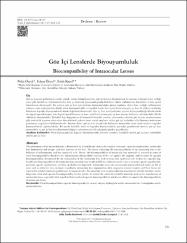Biocompatibility of Intraocular Lenses
Özet
The performance of an intraocular lens is determined by several factors such as the surgical technique, surgical complications, intraocular lens biomaterial and design, and host reaction to the lens. The factor indicating the biocompatibility of an intraocular lens is the behavior of inflammatory and lens epithelial cells. Hence, the biocompatibility of intraocular lens materials is assessed in terms of uveal biocompatibility, based on the inflammatory foreign-body reaction of the eye against the implant, and in terms of capsular biocompatibility, determined by the relationship of the intraocular lens with residual lens epithelial cells within the capsular bag. Insufficient biocompatibility of intraocular lens materials may result in different clinical entities such as anterior capsule opacification, posterior capsule opacification, and lens epithelial cell ongrowth. Intraocular lenses are increasingly implanted much earlier in life in cases such as refractive lens exchange or pediatric intraocular lens implantation after congenital cataract surgery, and these lenses are expected to exhibit maximum performance for many decades. The materials used in intraocular lens manufacture should, therefore, ensure long-term uveal and capsular biocompatibility. In this article, we review the currently available materials used in the manufacture of intraocular lenses, especially with regard to their uveal and capsular biocompatibility, and discuss efforts to improve the biocompatibility of intraocular lenses.
Kaynak
Turk Oftalmoloji Dergisi-Turkish Journal of OphthalmologyCilt
47Sayı
4Bağlantı
https://doi.org/10.4274/tjo.10437https://app.trdizin.gov.tr//makale/TWpnM016YzJOZz09
https://hdl.handle.net/20.500.12809/1873


















